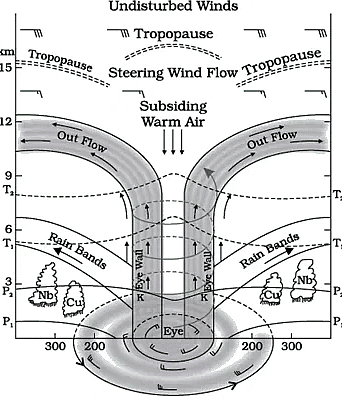Cyclones: All Explained | SSC CGL Tier 2 - Study Material, Online Tests, Previous Year PDF Download
Cyclones: Nature's Coiled Forces
Cyclones, characterized by low-pressure systems and swift inward air circulation, are meteorological phenomena impacting weather patterns. In the Northern Hemisphere, their circulation is counterclockwise, while in the Southern Hemisphere, it's clockwise. Originating from the Greek word "Cyclos," meaning snake coils, the term was coined by Henry Paddington, inspired by the resemblance of tropical storms in the Bay of Bengal and the Arabian Sea to coiled sea serpents.

Anticyclones: Counterbalance of Calm
Conversely, anticyclones exhibit clockwise winds around high-pressure areas in the Northern Hemisphere, inducing fair weather. As air descends from above, these systems create stable atmospheric conditions.
Cyclogenesis: The Birth of Cyclones
Cyclogenesis encompasses various processes leading to cyclone formation. Tropical cyclones emerge near the equator over warm ocean waters.
- The cycle involves the ascent of warm, moist air, forming low-pressure zones, followed by the influx of cooler air.
- This perpetuates the cycle, fostering cloud development and ultimately resulting in cyclones. Tropical storms arise with winds surpassing 63 mph, escalating to hurricanes at 119 mph.
Global Variety: Local Names and Naming Process
Cyclones go by different names globally: hurricanes in the Atlantic and Eastern Pacific, typhoons in Southeast Asia, and cyclones in the Indian Ocean and Western Pacific around Australia. The World Meteorological Organization manages cyclone names, alternating between male and female designations across six rotating lists. Names associated with destructive storms are retired.
Diverse Manifestations: Types of Cyclones
Two primary types of cyclones exist:
Tropical Cyclones:
- Defined by winds exceeding 'Gale Force.'
- Form in tropical or subtropical oceans, causing havoc with violent winds and heavy rainfall.
- Conditions for formation include warm sea surfaces, Coriolis force, varied vertical wind speed, and pre-existing low-pressure areas.
Extratropical Cyclones:
- Also known as temperate or frontal cyclones.
- Active in mid-latitudinal zones between 35° and 65° latitude.
- Form through the collision of polar and tropical air masses, generating fronts and displaying west-to-east movement.
The Lifecycle Unveiled: Stages of Cyclone Formation
Tropical cyclones undergo three stages:
Formation and Initial Development:
- Involves the transfer of water vapor and heat from warm oceans to the air.
- Evaporation stimulates the creation of vertical cumulus clouds.
Mature Stage:
- Intensification leads to powerful thunderstorms and the formation of a warm 'Eye.'
- Mature cyclones exhibit concentric patterns of turbulent cumulus bands.
Modification and Decay:
- Weakening occurs as warm moist air supply diminishes, often due to land interaction or cooler waters.

Extratropical Dynamics: Temperate Cyclones Unveiled
- Extratropical cyclones, active in mid-latitudinal zones, result from the collision of polar and tropical air masses.
- The Polar Front theory explains their formation, highlighting the interplay of warm-humid and cold-dry air masses.
- In contrast to tropical cyclones, extratropical cyclones exhibit a more constant temperature profile.
In Summary: Nature's Dynamic Dance
Cyclones, whether tropical or extratropical, showcase the intricate ballet of atmospheric forces. Understanding their formation, dynamics, and global variations is crucial for predicting and mitigating the impacts of these powerful meteorological events.
Cyclones Impacting India: Nature's Fury Unleashed
Tropical Cyclones in Indian Waters
The Bay of Bengal, Arabian Sea, and Indian Ocean emerge as prime regions for tropical cyclones, wreaking havoc on the coastal states of India. Tamil Nadu, Andhra Pradesh, West Bengal, Odisha, and Gujarat bear the brunt of these destructive storms due to their vulnerability. Characterized by formidable winds and heavy rainfall, these cyclones leave a trail of destruction in their wake.
Devastation Unveiled: Elements of Destruction
Tropical cyclones unleash destruction through three main elements:
Strong Winds/Squall:
- Damaging installations, residences, communication systems, trees, and structures.
- Resulting in casualties and significant property loss.
Torrential Rains and Inland Flooding:
- Posing a severe threat to those who lose shelter.
- Extensive rainfall leading to widespread soil erosion and embankment degradation.
Storm Surge:
- Inducing abnormal sea level rise along the coast.
- Inundating low-lying coastal areas, causing casualties, eroding beaches, destroying vegetation, and reducing soil fertility.
Cyclone Management: Structural and Non-Structural Approaches
Efficient management of cyclone disasters involves a dual approach:
Structural Methods:
- Construction of cyclone shelters, resilient buildings, and infrastructure like roads, culverts, bridges, canals, and communication networks.
- Implementation of saline embankments, surface water tanks, and power transmission networks.
Non-Structural Methods:
- Deployment of early warning systems, coastal zone management, catastrophe risk management, and capacity building for all stakeholders.
- The National Cyclone Risk Mitigation Project (NCRMP), aided by the World Bank, addresses these measures on a state-specific basis.
Cyclones: A Force of Balance and Vitality
Cyclones, beyond their destructive nature, serve essential roles:
Heat and Energy Transfer:
- Facilitating the transfer of heat and energy from tropical to temperate latitudes.
- Integral to the global atmospheric circulation system.
Environmental Rejuvenation:
- Contributing to aquifer replenishment, balancing ocean temperatures, and enriching the sea with nutrients.
- Augmenting river and stream flow, aiding in waste removal.
While cyclones bring peril to human populations, they also serve as nature's remedy, alleviating drought conditions and playing a pivotal role in the broader cosmic context, observed not only on Earth but also on distant celestial bodies like Mars, Jupiter, and Neptune. The intricate dance of destruction and rejuvenation marks cyclones as a force of both threat and essential balance in the natural order.
|
1335 videos|1437 docs|834 tests
|
















